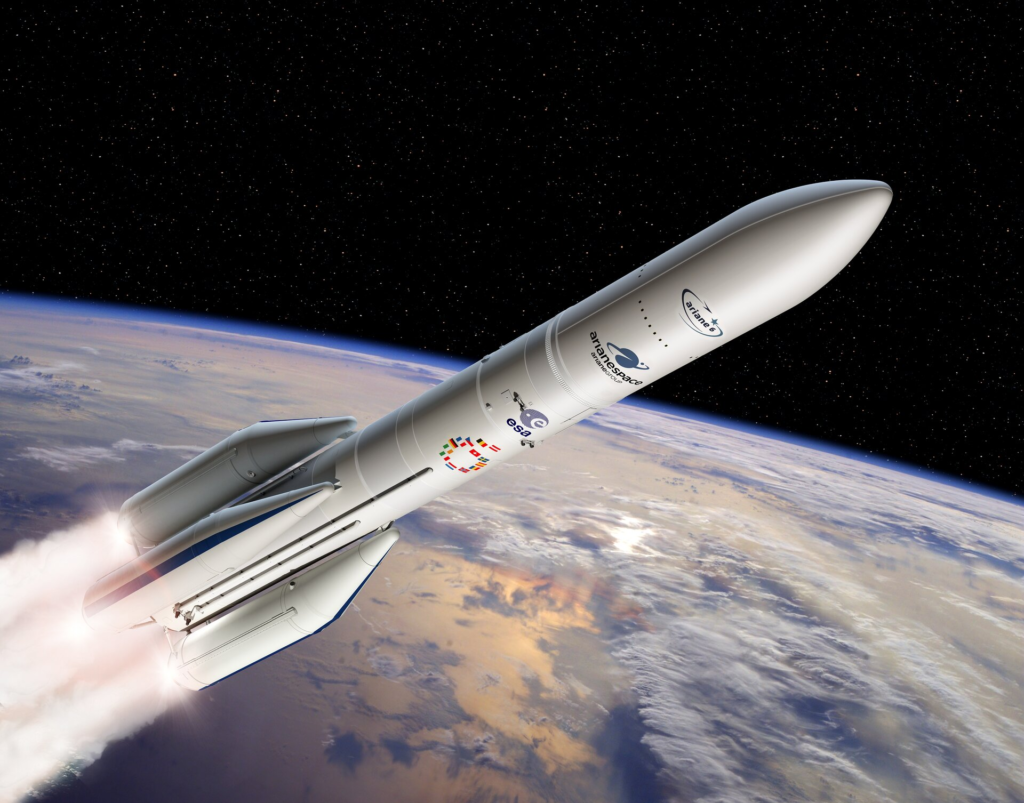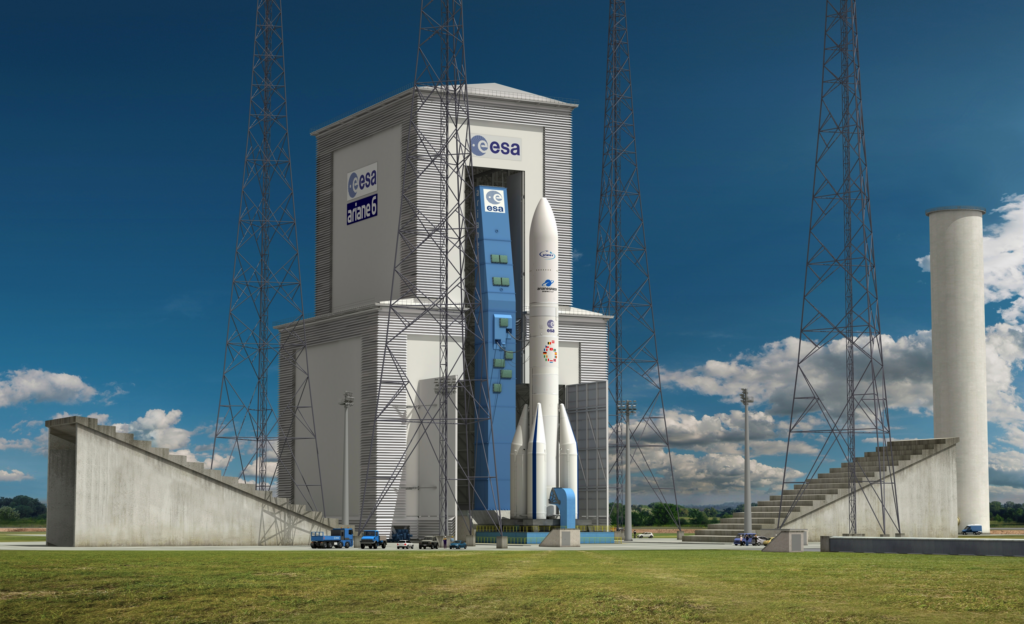
ESA’s Ariane 6 Rocket Has Been Delayed
Since 2010 the European Space Agency and Arianespace have been working to develop, test, and make progress toward the first launch of the Ariane 6 rocket. Intended to replace the Ariane 5, this launch vehicle is expected to provide new levels of efficiency and flexibility to meet customers’ launch services needs across a full range of commercial and institutional missions.
Unfortunately, this rocket’s initial launch date which has been pushed back multiple times before, was just delayed again. Specifically, just two days ago on October 20th, ESA officials announced the rocket’s new expected launch date will be in the fourth quarter of 2023. This comes as a result of multiple factors including a new power unit, delays in testing, and more.
This delay is quite a big deal as not only does it add quite a bit of time before this important first test, but it will also cost the European Space Agency an estimated 600 million euros or around 590 million dollars. An expensive price to pay that does not help with the agency’s future plans. Here I will go more in-depth into the recent delay, a closer look at the Ariane 6 launch vehicle, what to expect in the future, and more.
New Delays

On October 20th ESA tweeted saying, “Yesterday, ESA Director General @AschbacherJosef announced that sufficient progress on @Ariane6 has been made over the last few months to anticipate a Q4 2023 first flight, pending three key milestones before April next year.” While this tweet makes it sound like the rocket is right on time, in reality, this confirms another delay until late next year. Specifically, on the 19th, a conference was held where the Director General gave some insight into some of the tests still necessary and when we could expect this rocket to lift off.
In addition, he explained that recent progress has made it possible to plan for an inaugural Ariane 6 launch during the final quarter of 2023 – but, he stressed: “With a project of this magnitude it needs to be clear that this is a planned date and the program will still need to make the successful and timely achievement of a number of key milestones for this schedule to remain valid.” In this case, three critical milestones must be achieved by the first quarter of 2023. One is the successful completion of the upper stage hot firing test campaign begun earlier this month at the engine and stage testing center of Germany’s DLR aerospace agency. The second critical milestone will be to begin hot firing tests of Ariane 6’s core stage, with its Vulcain 2.1 engine, on the launch pad. Vulcain 2.1 hot-firing tests are part of the combined test campaign to validate the rocket and launch pad as a unified system. That campaign is now moving forward, as full stacking on the launch pad of a complete test model of Ariane 6 was realized earlier this month. The final critical milestone of this inaugural launch plan depends on the start of the launch system qualification review also by the first quarter of 2023.
Unfortunately, all of which suggest that more delays are possible. In reality, we likely won’t see this first launch until early to mid 2024. This being said, the Ariane 6 launch vehicle is still expected to play a significant role in different future missions and more. Currently, the company has already sold 29 Ariane 6 launches. Not to mention, Arianespace’s chief executive, said in the same news conference, “We see an accessible market for Ariane 6 and [the lightweight rocket] Vega to be 4 billion euro per year this decade, as opposed to 2 billion during the 2010 to 2020 decade.” One of these big future contracts has to do with Amazon.
Earlier this year they announced an unprecedented launch service contract with Amazon. Under the terms of the contract, Arianespace will perform 18 Ariane 6 launches for Amazon’s Project Kuiper over a period of three years from Europe’s Spaceport. Among the 18 launches planned for the deployment of Project Kuiper, 16 will be carried out with an advanced version of the Ariane 64. At the time, the CEO of Arianespace pointed out, “This contract, the largest we’ve ever signed, is a great moment in Arianespace’s history. We are honored to be given a significant role to play in the deployment of Amazon’s Project Kuiper, which aims to connect tens of millions of people to the internet. It will build on the European innovative spirit, industrial might, and years of experience of the Ariane partners. That Amazon has chosen the Ariane 6 to do the job is a matter of tremendous pride for us and a great vote of confidence for our new launch vehicle. This day marks a decisive success for the Ariane 6 Program and all its value chain in Europe.”
Ariane 6 Overview

Now that we know more about the recent delays and what the Ariane 6 rocket needs to complete prior to its first launch, we can take a closer look a the rocket itself and what makes it special. Ariane 6 is a European expendable launch system currently under development since the early 2010s by ArianeGroup on behalf of the European Space Agency (ESA). It is intended to replace the Ariane 5, as part of the Ariane launch vehicle family, which stretches back quite a bit. The goal for this launch vehicle is to provide Arianespace with new levels of efficiency and flexibility to meet customers’ launch service needs across a full range of commercial and institutional missions.
To try and ensure Arianespace’s continued competitiveness, this next-generation launcher has been conceived for reduced production costs and design-to-build lead times, all while maintaining the quality and reliability that have made Ariane 5 an industry leader. Ariane 6 features a modular configuration based on core stages powered by lower and upper liquid propellant modules, which are supplemented by either two or four strap-on solid rocket motors. Enhancing Ariane 6’s competitiveness is the series production of its rocket engines and a technology-sharing approach with Arianespace’s Vega C – particularly this lightweight launcher’s P120 engine that also will be used in Ariane 6’s solid rocket motors.
These configurations allow for two different variants of Ariane 6. This includes Ariane 62 with two solid rocket motors and Ariane 64 with four solid rocket motors. The less powerful variant has a payload capacity to low Earth orbit of 10,400 kilograms and 4,500 to geostationary, while the 64 variant has more than double at 21,600 kilograms to LEO and 11,500 to GEO. Moving to the upper stage, the Vinci engine was conceived to enhance the Arianespace heritage of reliability, earned by its predecessor HM7B. The new engine has the capability of restarting up to five times, allowing Ariane 6 to reach a range of orbits on a single mission to deliver more payloads. Also, Ariane 6 will introduce an innovative service providing fast-track access to Geosynchronous Equatorial Orbit, for the new generation of small satellites, offering a first flight opportunity with more than 4.500 kg of such payloads on its “GO1” mission. Configured with the Multi-Launch Service carrying system (MLS), the new launcher will accommodate a full range of small-sized satellites, from CubeSats to microsats or larger.
The capabilities of this next-generation launcher, the flexibility of its configuration, alongside Arianespace’s proven multiple mission management ability, enables Ariane 6 to carry any type of spacecraft, from the smallest (1.000 kg or less) to the largest (>20.000 kg), in either dedicated or shared launch. Moreover, a specific set of accommodation solutions for small satellites, from CubeSats to minisatellites up to more than 400 kg, will be available. These smallsats launch solutions, in piggyback (with one or several main passengers) or rideshare (no main passenger) configurations, will be commercialized as “Multi-Launch Service” or MLS.
Looking at its equally important facilities and launch complex, the Guiana Space Center (CSG) offers ideal conditions for launching any payload to any orbit at any time. Located at 5 degrees North latitude, its proximity to the equator provides an extra boost of energy due to the Earth’s rotation – a slingshot effect that is greater here than at most other launch sites. The CSG provides modern Payload Preparation Facilities that are recognized for their high quality in the space industry. The facilities are capable of processing several spacecrafts from different customers simultaneously, thanks to vast clean-rooms and commodious infrastructure. Designed to support the rockets’ multiple launch capability and high launch tempo, the preparation facilities meet the needs of customers using any of the three vehicles in the Arianespace family and its two next generation launch vehicles. All of which works together to both create and support this launch vehicle. While the recent delays are not ideal, the agency is continuing to work on the rocket and is hopeful it will be ready to launch late next year.
Conclusion
The Ariane 6 rocket has had quite an eventful development since 2010. This has included quite a few delays over time as the rocket and various necessary tests have been pushed back. Recently we got more news following a similar theme as the agency announced that the earliest we could see the rocket lift off is late next year. We will have to wait and see how it progresses and the impact it has on the space industry.
